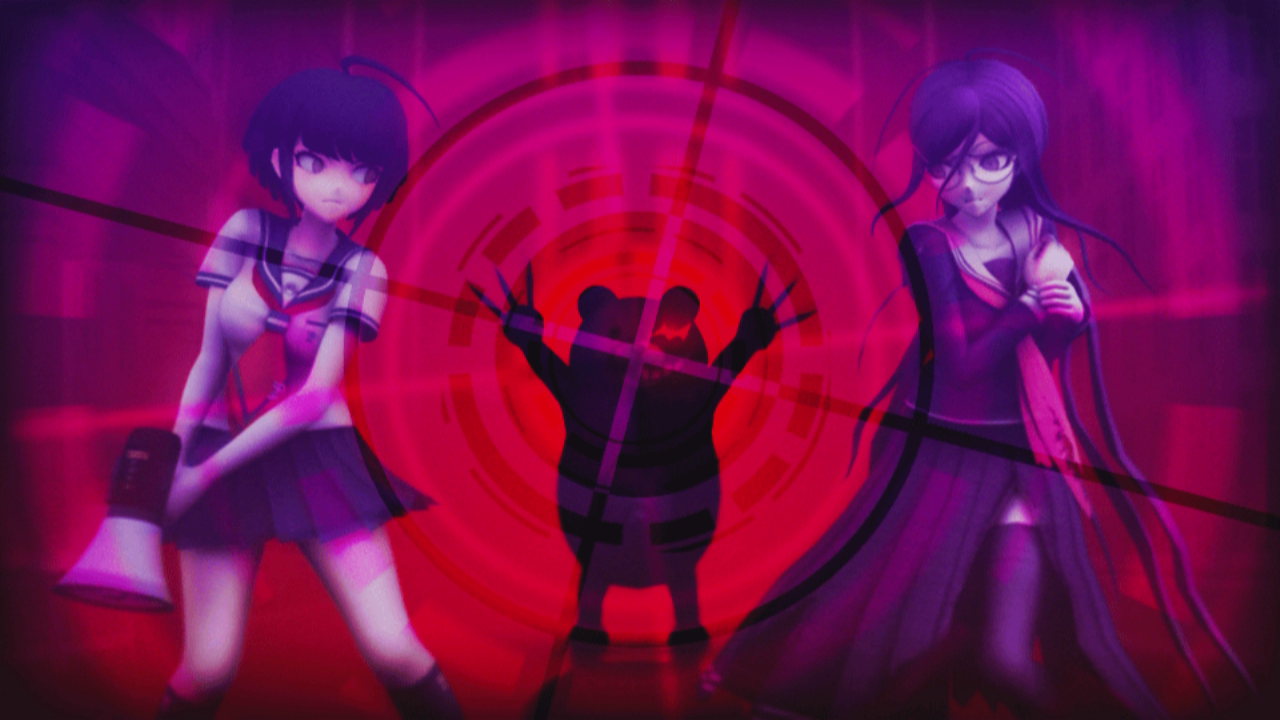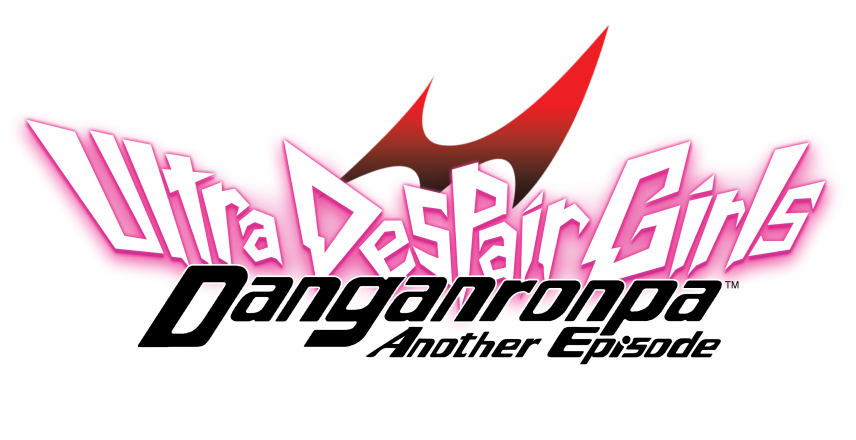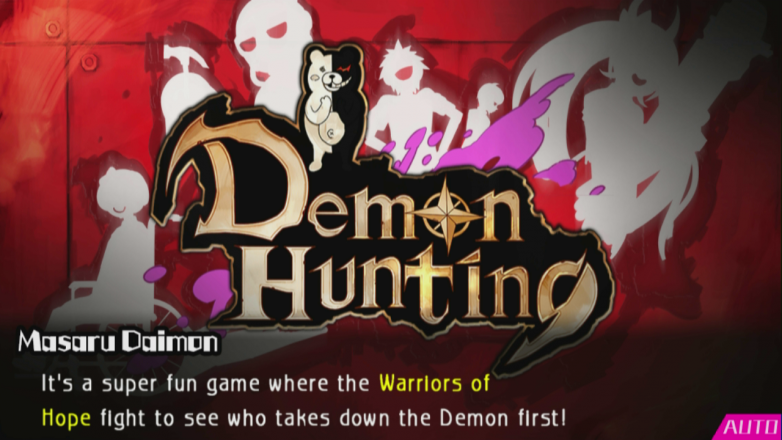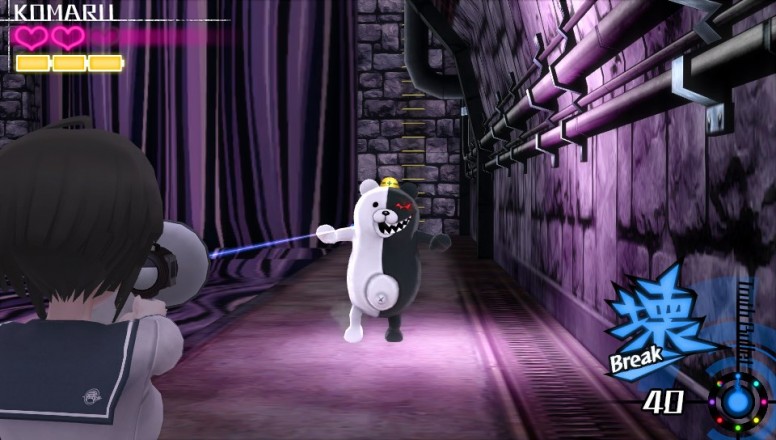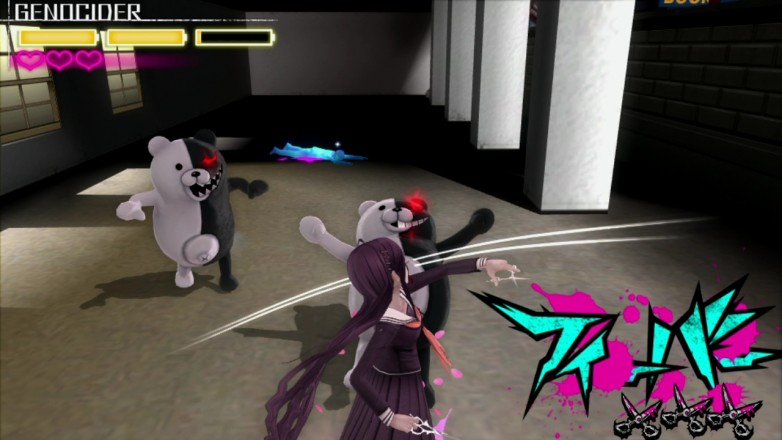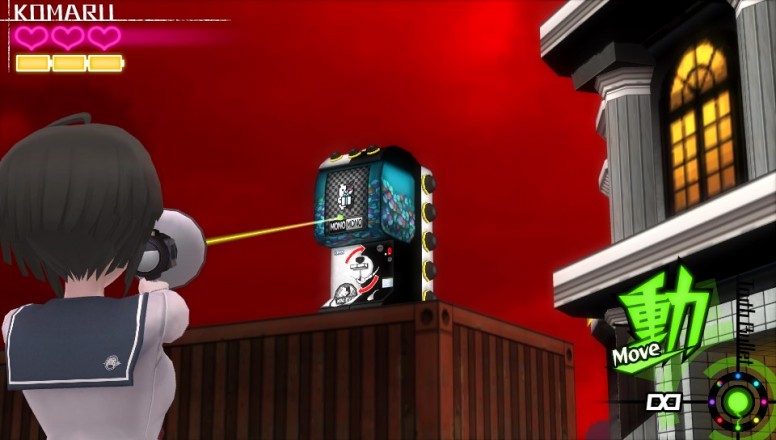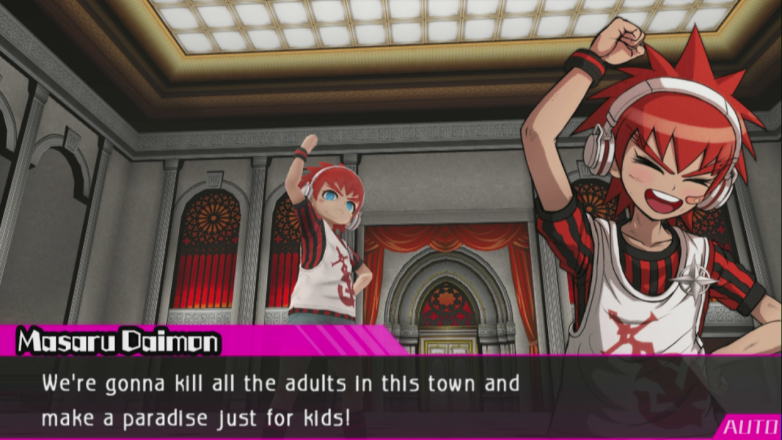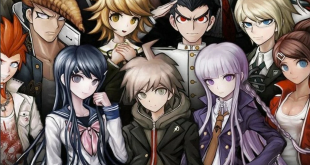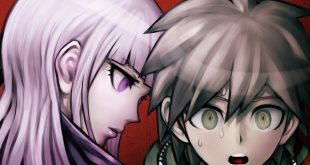Danganronpa Another Episode: Ultra Despair Girls is the latest release in Spike Chunsoft’s Danganronpa series, which has been warmly received by both critics and gamers. The first two games in the series are visual novels that focus heavily on puzzles, mystery, adventure, investigation, and dark, intense themes. Another Episode ditches the traditional visual novel style in favor of a third person shooter. Now, I know what you’re thinking – it’s great when franchises try new things, but isn’t that a bit too different? I thought the same thing. But the shooting mechanics actually work pretty well, and the classic Danganronpa art style is still here along with the puzzles, plot twists, and insanely dark ideas that make Danganronpa such a unique series. The game has been branded as a “spin-off,” but a lot of the people who were key figures in the creation of the original Danganronpa games (like writer Kodaka Kazutaka) helped with Another Episode – even though it’s not the Danganronpa game that we were expecting, Another Episode is a lot of fun, and now I can’t imagine the series without the story that this game adds to the franchise.
Another Episode is extremely easy to spoil, so we won’t go into much detail regarding the story in this review. I also recommend that you play Danganronpa: Trigger Happy Havoc and Danganronpa 2: Goodbye Despair before diving into Another Episode. This is because Another Episode takes place between the two games, so it’ll completely spoil the first game for you while making the twists and turns of the second game significantly less surprising. It’s also really cool to play Another Episode with the knowledge of what happens in the second game – if you do, a lot of seemingly minor details will become more interesting (full disclosure – I’m a huge fan of the series, and I came into this game having played the other two games multiple times). You’ll be playing as Komaru Naegi, the little sister of Trigger Happy Havoc‘s protagonist. Komaru has been kept in captivity for over a year, and the story begins when she is suddenly released from her confinement only to find that the world outside is much more twisted than she remembers. After a failed rescue attempt and an encounter with five elementary-school children who call themselves the Warriors of Hope, she ends up being cast as a “demon” in a death game the kids are playing – the children race against one another to see who can kill the most “demons” (adults) first. Upon being released into the city for the start of the game, Komaru meets and starts working alongside Toko Fukawa, the game’s other main character (and a returning character from the first game). Both Komaru and Toko are extremely well-developed throughout the game, and when you look back on the first chapter of the game, it’s incredible to see how far the two girls have come. This goes for both Komaru and Toko, but Danganronpa fans will most likely be more impressed by Toko’s growth, since her character wasn’t really elaborated on in the first game. Anyway, most of your time will be spent guiding Komaru and Toko through Towa City, fighting Monokuma robots and trying to stop an evil plan being carried out by The Warriors of Hope – though not everything is as simple as it might seem.
I want to take a second to warn you: Another Episode is probably the darkest Danganronpa game to date. The subjects covered throughout the story are extremely traumatic, and people who have experienced trauma in any way similar to the events described in the game might find themselves being triggered. I still recommend this game to all fans of Danganronpa, but I do recommend that you pay attention to the themes being discussed so you’ll know when you need to skip a scene or take a break. Despite the light robot-shooting gameplay that comprises most of the game, Another Episode can get pretty heavy. Fortunately, the team at Spike Chunsoft did a pretty good job of being respectful of the sensitive nature of the topics they discuss – with the exception of a particularly disturbing scene (and a horrid “joke”) in Chapter 3. But even with the issues in Chapter 3, that plot line does ultimately get treated with a decent amount of decency. I know this is difficult to fully understand, but NIS has requested that we not discuss specific story events beyond Chapter 1. However, I think these things are important to any review of this game. I commend Another Episode for being willing to take the series even darker than anyone thought was possible while still managing to inject positive messages and inspiring stories into the game. The story might seem a bit silly at first (mainly in the prologue), but it quickly gets more complicated and interesting. Even when I was entering my seventeenth hour with the game (I finished the story in about 18 hours), I was still completely invested in Komaru and Toko’s story and I didn’t want to put my Vita down, even after the credits rolled. In fact, I immediately loaded my save data and started up a New Game +.
As was mentioned above, Another Episode focuses largely on third person shooter mechanics. Above you can watch the launch trailer for the game, which shows off the different kinds of Monokuma robots you’ll be fighting and will let you get a feel for how the over-the-shoulder shooter system works. It’s an easy system to wrap your head around – hold the left trigger to aim, and press the right trigger to shoot. You can customize the way the camera moves (automatically vs manually) and you’ll be able to speed up or slow down the movement of your aiming reticle through skills that you’ll earn and/or find in-game. By the end of the game, you’ll have acquired eight different types of ammunition (called “truth bullets”) for your hacking gun. Each type of ammunition has a different effect, and experimenting with different ways to take down the different types of robots (as well as figuring out good combos and efficient ways to take out groups) make the game more entertaining and unique than if you were just wielding normal guns. By using “bling bullets” that you buy at in-game shops, you’ll be able to customize the effect, speed, and capacity of most truth bullet types. Each of the customizable truth bullets can take two bling bullets, and cute little cartoon versions of Komaru and Toko will let you know how good your chosen combination is. As you defeat robots and make progress, you’ll earn XP that you can track in the start menu. As you level up, you’ll get more skill points, which will let you activate more skills at once (skills can be anything from raising max HP to increasing the likelihood of item drops). Are these mechanics anything we haven’t seen before? No, not really. They’re still fun, though. Aiming for a Monokuma’s weak spot and getting an encouraging “nice shot!” message as well as a super-powered bullet for your next shot feels awesome – like I said, this kind of thing isn’t new, but it doesn’t mean that it’s not fun. It is, however, very new for the Danganronpa series, and when paired with everything else Another Episode has to offer, Komaru’s shooting works, and I can’t imagine this game having been made any other way.
Toko fights, too, though. Well, Toko doesn’t really fight – she’s not the confrontational type, really. Instead, her other personality (she has Dissociative Personality Disorder), Genocide Jack (sometimes called Genocide Jill from a joke she made in the first game), is more than happy to skip along the front lines, slaughtering every Monokuma that dares to come close. Even before being upgraded, Genocide Jack is quite powerful, and I initially intended not to use her very much because I thought that it would be “too easy.” But, quite honestly, it’s just too much fun to resist. Your time as Genocide Jack is limited (though it can be extended quite a bit through upgrades), but every second of it is awesome. She is absolutely brutal, and she rips through enemies with her signature sewing scissors (her “genoscissors”). In addition to these melee attacks, you can also perform slash lust attacks once your lust meter (shown at the bottom right of the screenshot below) is full. These are gorgeous executions that use the art style that was used in the execution scenes in the other Danganronpa games. With Komaru’s shooting, Genocide Jack’s high-speed melee attacks, and the cool types of slash lust attacks and truth bullets, combat in Another Episode is a lot of fun. It does get a bit repetitive sometimes, but I found myself experimenting with the combat possibilities in such a way that it never really bothered me, especially with the way that new Monokumas and truth bullets are constantly being introduced. Boss fights also change things up, as well as environments that limit the ways that you can use your weapons.
When you’re not fighting, you’ll be solving puzzles. Komaru and Toko frequently come across rooms that have a strange arcade machine in them. Using the “move” truth bullet on the machines will display a security camera feed of the next room and the challenge that the girls are supposed to complete. These are usually things like “destroy them all with one explosion,” “destroy them all with electricity,” or something like that, but you’ll occasionally get challenges like “don’t let them see you” or something else that doesn’t focus on destroying everything at the same time or in the same way. Interestingly enough, you actually don’t have to complete the challenge to move through most rooms. If a room asks you to destroy all the enemies with one explosion, but you simply switch to Genocide Jack and rip them apart in seconds, you’ll still be able to move on – it’ll just have a negative effect on your score at the end of the episode, which, in turn, lowers the amount of coins you’ll be awarded after the chapter as well as ruining your chance at getting a few trophies. However, even if you don’t really care about the coins or trophies, the game is much more fun when you actually try to complete the challenges that you’re faced with. These puzzle rooms are probably the most interesting and refreshing part of Another Episode, and I was always very happy when I came across one. In addition to this, you’ll find puzzles and riddles all over the game – in each chapter, there are five “hidden kids” to find – you’ll need a special truth bullet to do it, but looking for them becomes something of an obsession, especially on a second playthrough. There are also rooms that remind me of the Zero Escape series – you’ll have to investigate to find a passcode for the exit door or to find a way to move forward. In addition to these puzzles, you also have an incredible amount of collectibles to find that really flesh out the world of Danganronpa. You’ll read about key events and people in the series, as well as information that makes the story of Another Episode more compelling. Collecting certain collectibles will also start entertaining conversations between Komaru and Toko, and these really help to develop their characters as well as their relationship. When it comes to replay value, these collectibles are definitely an encouragement, but most of them are only going to be entertaining for hardcore Danganronpa fans. For everyone else, whether or not you go for multiple playthroughs is going to depend on whether or not you feel like earning all the trophies and playing through the game with all the skills and bling bullets you earned in your previous playthrough. Once you beat the game once, there are some cool things that are unlocked that aren’t related to playing the game again, so even if you don’t play it again right away, there’s still a reason to spend a few extra hours with Another Episode after you finish the main story.
The game looks great on the PS Vita. The cutscenes are particularly impressive – the art style of the other Danganronpa games is blended together with anime-style art to create visually impressive cutscenes that I didn’t want to skip – even on my second playthrough. During gameplay, the visuals are crisp and smooth, but some of the environments tend to blend together. There are definitely exceptions (there are areas that are really unique and are a lot of fun to walk through), but as a whole there’s a lot more that could have been done with the environments – particularly areas designed especially for battles against hordes of robots. The sound in Another Episode is excellent – you’ll recognize some music from the other games, while there are also some new tracks. Even better is the voice acting. The actors and actresses in this game are very talented, particularly those who play Komaru, Toko, Haiji, and Monaca. You’ll definitely want to play this one with headphones, because it’s just not the same experience if you’re not hearing all the things that are going on in Another Episode.
It’s hard to capture the essence of a Danganronpa game in a review, and that definitely applies to Another Episode. I could write a few more paragraphs explaining the intricacies of the game’s story or genre-blending gameplay, but there’s really no way to do it justice – you’ll just have to experience it for yourself. That being said, I do highly recommend Another Episode for anyone who enjoys dark, story-based games. Fans of third person shooters probably won’t be intrigued by the title, so it’s the other elements that are going to attract players to the game. If you’re a Danganronpa fan, there’s really no question here – you will love this game, so you should pick it up ASAP. This isn’t the “Danganronpa 3” that many fans were hoping for, but it’s still something that’s absolutely essential to the series, and it’s a fantastic addition to the PS Vita library. Spike Chunsoft and NIS took a risk with this game, and it more than paid off – Another Episode proves that the Danganronpa series succeeds because of its characters, its stories, and its love of innovation – not just because of its traditional visual novel format. This is one of the best PS Vita releases so far this year, and it’s definitely worth checking out.
Review copy provided by NIS America
Gameplay - 8
Story - 9
Visuals - 8.5
Sound - 8
Replay Value - 8
8.3
GREAT
Though it won't please everyone, Ultra Despair Girls is an impressive game that brings the darkness and story complexity of the Danganronpa series into new territory, and it's a refreshing change of pace for the series - even if it isn't the Danganronpa 3 that many fans were expecting.
 Load the Game Video Games, Reviews, Game News, Game Reviews & Game Video Trailers
Load the Game Video Games, Reviews, Game News, Game Reviews & Game Video Trailers
